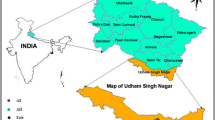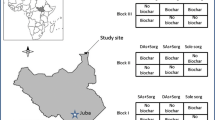Abstract
We examined the effects of intercropping with Acacia senegal (L.) Willd on growth and yield of sorghum (Sorghum bicolor L.), sesame (Sesamum indicum L.) and roselle (Hibiscus sabdariffa). Field experiments were conducted in El-Obeid Research farm (13°10′ N; 30°12′ E), North Kordofan State, Sudan, during 2002–2003 in an 11-year-old A. senegal plantation. The experimental design was randomized complete block design (RCBD) with four replications. Data were recorded for plant height (cm), fresh weight (kg·ha−1), dry weight (kg·ha−1), crop yield (kg·ha−1), and gum yield (kg·ha−1). We used Land Equivalent Ratios (LER) and simple financial analyses of gross surpluses to evaluate the productivity and profitability of the different treatments. The results indicated that A. senegal trees had a beneficial effect on crop performance and yield as well as gum yield. Significant differences (p < 0.05) were obtained for plant height, fresh weight, dry weight and crop yield. Therefore, yield of sorghum, sesame and roselle under intercropping system were 13.7%, 23.8% and 20.9% higher than that obtained in the sole cropping system respectively. The highest yield increase was observed with sesame (23.8%). Gum yield (g/tree/picking) was significantly (p < 0.05) increased for sorghum, sesame and roslle under intercropping system. The highest yield of (298 g/tree/picking) was obtained when roselle was intercropped with A. senegal, while the least gum yield of (239 gδtree−1) was recorded in pure A. senegal plot. All the treatments gave land equivalent ratio (LER) of more than one-indicating the superiority of growing the field crops in intercropping over the sole cropping systems. The highest LER of 3.8 was obtained for sesame intercropped with A. senegal (Hashab), followed by 3.7, when sorghum was intercropped with A. senegal and 3.3 when roselle intercropped with A. senegal. All the treatments gave positive net revenues, the highest being for intercropped sorghum (558 SDG·ha−1) (SDG=Sudanese gienh). The intercropping of roselle gave the second net revenue (518 SDG·ha−1), while the sole sorghum gave the lowest net revenue (501 SDG·ha−1).
Similar content being viewed by others
References
Ahmed AAS. 1990. Growth and yield of certain agricultural crops under alley cropping with Leucaena leucocephala. M.Sc. thesis. Khartoum: University of Khartoum.
Ahmed EHA. 1986. Some aspects of dry land afforestation in the Sudan with special reference to Acacia tortilis (Forks) Hayne, A. senegal Willd. and Prosopis chilensis (Molina) stuntz. Forest Ecology and Management, 16: 209–221.
Badi KHM, Ahmed AE, Bayoumi MS. 1989. The forest of the Sudan. Khartoum: Forest National Corporation.
Ballal ME, ElSiddig EA, El Fadl MA, Luukkanen O. 2005. Gum Arabic yield in differentially managed Acacia senegal stands in western Sudan. Agroforestry Systems, 63: 237–245.
Ballal ME. 1991. Acacia senegal: amulti-pupose tree species for the arid and semi-arid tropics. M.Sc. theses. Cardiff, UK: University of Wales.
Ballal ME. 2002. Yield trends of gum Arabic from Acacia senegal as related to some environmental and managerial factors. PhD thesis. Khartoum: University of Khartoum. p.105.
Bashir M. 2001. Sudan country on biodiversity. Khartoum, Sudan: Silver Star Press.
Beets WC. 1982. Multiple cropping and tropical farming systems. Colorado: West view press, Inc.
Belsky AJ. 1994. Influences of trees on savannah productivity: tests of shade, nutrients, and tree-grass competition. Ecology, 75(4): 922–932.
Beshai AA. 1984. The economics of a primary commodity: Gum Arabic. Oxford Blletin of Economics and Statistics, 46(4): 371–381.
Buresh RJ, Tian G. 1998. Soil improvement by trees in sub-Saharan Africa. Agroforestry Systems, 38: 51–76.
CIMMYT. 1988. From agronomic data to farmer recommends tions: an economics workbook. Mexico, D.F.: CIMMYT.
Elmgvist B. 2003. The vulnerability of traditional Agroforestry systems: a comparison of the gum Arabic livelihood strategy before 1984 drought to that of present in Kordofan-Sudan. Uppsala, Sweeden: paper presented on Environment, Place and Sustainable Natural Resources Management Conference.
Fadl KEM, Gebauer J 2005. Growth and yield of groundnut, millet, and sesame alley-cropped with Acacia senegal in North and South Kordofan, Sudan. Tropical Agriculture, 82(3): 225–229.
Fadl KEM, Gebauer J. 2004. Crop Performance and Yield of Groundnut, Sesame and Roselle in an Agroforestry Cropping System with Acacia senegal in North Kordofan (Sudan). Journal of Agriculture and Rural Development in the Tropic and Subtropic, 105(2): 149–154.
Fadl KEM, Sheikh SEE. 2010. Effect of Acacia senegal on growth and yield of groundnut, sesame and roselle in an agroforestry system in North Kordofan State, Sudan. Agroforestry Systems, 78(3): 243–252.
Fadl KEM. 1999. Growth and yield of some agricultural crops under alley cropping with Acacia senegal (L.) Willd on sandy soils. M.Sc. thesis. Khartoum: University of Khartoum.
Fischer SD. 1990. MSTAT-C statistical package. Michigan State University, USA.
Gaafar AM. 2005. Improvement of traditional Acacia senegal Agroforestry: Ecophysiological characteristic as indicators for tree -crop interaction on sandy soil in western Sudan. PhD thesis. Helsinki: University of Helsinki.
Hussein SG, El Tohami AE. 1989. The influence of Acacia senegal plantations on some properties of a vertisol soil. Social Forestry and Environment, (4): 1–4.
Hussein SG, Sulieman HM. 1999. Effect of regeneration methods and weeding treatments on establishment of Acacia senegal (L.) Willd. on clay soils. Journal of Agricultural Sciences, 7(2): 61–69.
Hussein SG. 1983. A preliminary study of soils under Acacia senegal (L.) Willd. Sudan Silva, 5(25): 125–135.
Larson BA, Bromley DW. 1991. Natural resources prices, export policies and deforestation: the case of Sudan. World Development, 19(10): 1289–1297.
NAS. 1986. Tropical legumes. Washington, USA.
NKRDP. 2001. Baseline survey report. North Kordofan Rural Development Project-IFAD, El-Obeid Sudan.
Seif El Din A. 1984. Agroforestry practices in the dry regions. At-Tasahur, 2: 8–9.
Tiedemann R, Klemmedson JO. 1977. Effect of mesquite trees on vegetation and soils in the desert grasslands. Journal of Range Management, 30(5): 361–367.
Vandenbeldt RJ, Williams JH. 1992. The effect of soil surface temperature on the growth of millet in relation to the effect of Faidherbia albida trees. Agricultural and Forest Meteorology, 60: 93–100
Vetaas OR. 1992. Micro-site effects of trees and shrubs in dry savannas. Journal of Vegetation Science, 3(3): 337–344
Willey PW. 1997. A scientific approach to intercropping research. Proceeding of the international workshop on intercropping, ICRISAT, Hyderabad, India, 10–13, January, 1997
Zhang X, Karsisto M, Lindostorm K. 1992. Assessment of competitiveness of fast growing rhizobia infecting Acacia senegal using antibiotic resistance and melanin production as identification markers. World Journal of Microbiology & Biotechnology, 8(2):199–205.
Author information
Authors and Affiliations
Corresponding author
Rights and permissions
About this article
Cite this article
Fadl, K.E.M. Influence of Acacia senegal agroforestry system on growth and yield of sorghum, sesame, roselle and gum in north Kordofan State, Sudan. Journal of Forestry Research 24, 173–177 (2013). https://doi.org/10.1007/s11676-012-0319-4
Received:
Accepted:
Published:
Issue Date:
DOI: https://doi.org/10.1007/s11676-012-0319-4




